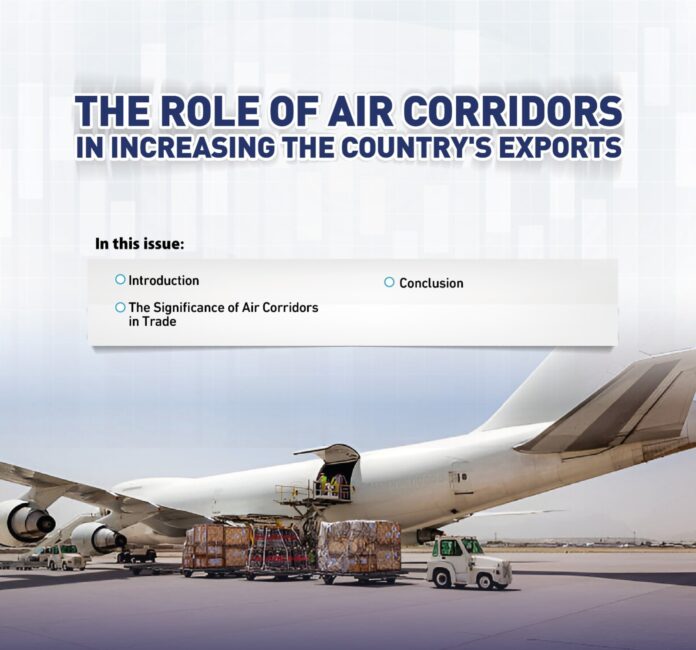Introduction
Afghanistan is a landlocked country with no direct access to the sea, which consistently causes challenges in trade activities.
In this context, air corridors hold special significance in facilitating the country’s trade.
Air corridors directly transport commercial goods to other countries, providing an efficient means for trade. Although the transportation of goods through air corridors can be costly, the reduced transit time and access to international markets offer clear advantages. Through air infrastructure, regional cooperation can increase, and trade can improve, allowing various countries to benefit from this opportunity.
Air corridors offer exporters the possibility to quickly and easily deliver their goods to prominent markets. Most goods transported through air corridors are those with high value and small volume, such as pharmaceuticals, technology-related equipment, and other valuable items. This can positively impact the country’s trade and economy.
The Significance of Air Corridors in Trade
For countries that are landlocked and have no direct access to the sea, air corridors are considered an excellent means of trade and integration with international markets. This concept has transformed trade transactions and played a remarkable role in the global economy.
Currently, there are around 31 such landlocked countries worldwide, including 15 African countries, 12 Asian countries, two Latin American countries, and two others from Central and Eastern Europe. While the trade volume of these countries is about 60% lower compared to countries with access to the sea, they are required to spend 50% more on transporting their goods.
In such countries, air corridors present an opportunity for economic growth, freeing them from reliance on neighboring countries. The products of landlocked countries must either be transported to international markets via neighboring countries or through air transport, which is costly.
Afghanistan, also a landlocked country with no direct access to the sea, was previously dependent on the transit routes of neighboring countries. However, around eight years ago, for the first time, 60 tons of Afghanistan’s agricultural products were transported to India via air, marking the opening of the first air corridor for Afghanistan.
The air corridor concept was first introduced in 2016 during the sixth Heart of Asia Conference in India, and in 2017, this corridor between Afghanistan and India was officially launched. Subsequently, air corridors with Kazakhstan, China, Turkey, Saudi Arabia, Russia, and the European Union were also established. According to 2019 statistics, 9,000 tons of goods were exported through 905 flights via air corridors.
The majority of these goods included dry and fresh fruits, vegetables, medicinal plants, precious stones, carpets, and karakuls. The Islamic Emirate, recognizing the role of air corridors, has made efforts to establish these routes.
One such route is the Kabul-Shanghai air corridor. Afghanistan and China have long maintained good relations, with the People’s Republic of China investing in some of Afghanistan’s mines and securing a contract for the extraction of oil in the Amu Darya basin. Additionally, trade relations between China and Afghanistan have strengthened.
To support these relations, the Islamic Emirate and the Chinese government jointly launched the Kabul-Shanghai air corridor, which was inaugurated in 2023 by Deputy Prime Minister for Economic Affairs, Mullah Abdul Ghani Baradar Akhund.
During the inauguration ceremony, the Deputy Prime Minister stated that Afghanistan’s economic situation is moving toward development, which is the result of the efforts of traders and industrialists, and the world recognizes Afghanistan’s growing economy. Through this corridor, Afghanistan’s agricultural and other products are being exported to China.
This clearly shows that the Islamic Emirate, considering the economic value of air corridors, has taken steps in this direction, and these efforts are ongoing. As a result, trade will expand on one hand, and on the other, Afghanistan’s exports will significantly increase, which can accelerate economic growth.
Conclusion
Air corridors are considered a good option under current conditions, but since the transportation cost is high, transporting many items this way may not be economically feasible.
The transportation of Afghanistan’s export goods, most of which are dry and fresh agricultural products, involves significant weight, and only small quantities can be transported via air corridors at a high cost. In the absence of sea routes, land transport, particularly railways, is considered an easier and more affordable option.
In addition to air corridors, there is a need to explore other solutions, such as extending railways with neighboring countries, utilizing the Lapis Lazuli route, strengthening certain new ports and routes, improving land connectivity with China through the Wakhan Corridor, and addressing existing transit issues.
These are considered more cost-effective and efficient methods for the commercial development of Afghanistan. To address these challenges, the Islamic Emirate of Afghanistan launched the Kabul-Shanghai air corridor in 2023, and efforts are ongoing to create further trade facilitation in other areas.


